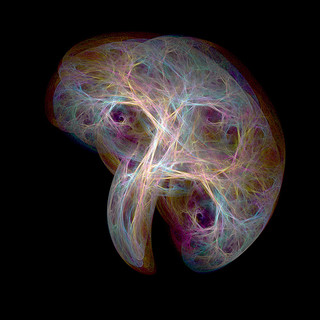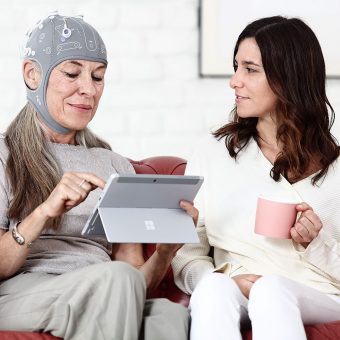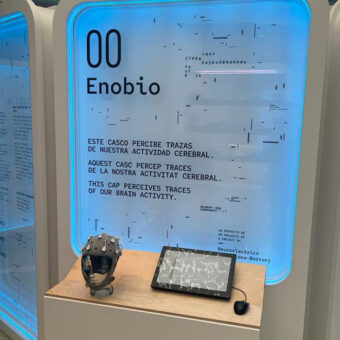EEG – electroencephalography – provides a tool to study brain activity. Neurons create electrical chatter while they go about their work, and this “noise” contains valuable information, providing a unique window to peer into brain function. Of course, we are still a long ways from cracking this particular code, but we are making constant progress thanks to advances in hardware (to improve signal-to-noise ratio), mathematics, signal processing and machine learning. Ultimately, machine learning will provide the key, I think, but this is another story for another post…
Incidentally, from the mathematical side it is interesting to mention a relatively recent result (1981): Takens’ theorem suggests that data from a single EEG channel contains – in a sense – all the information generated by a brain … SNR limitations notwithstanding. See this beautiful video for inspiration. There is “plenty of room at the bottom” of our signals, to paraphrase Feynman.
Back to EEG and tCS…
Some of the first studies in the field of electrical stimulation were based on electrophysiology: an electric current/field was applied to the target – an in-vitro brain slice or an animal’s brain – and the electrical activity changes of neurons were observed. Immediate effects of stimulation (i.e., those that appear as soon as stimulation is applied) were observed: the alteration of neuron firing rates. But also the so-called “after-effects”: the firing rate alterations did not go away immediately after the stimulation ceased, but after several minutes. See this paper by Bindman (1964), for example.

Generally speaking, it is particularly interesting to study EEG under external stimulation, as is currently done with event related potential techniques (using visual and aural stimulation, for example), as this allows us to probe particular sub-circuits and their function. Why not use electrical stimulation to do the task? tCS provides interesting tools for this: the use of different frequencies, multisite stimulation …. one just needs to come up with right experimental questions from a wide range of possibilities. What happens if we do this stimulation with so and so frequency over this cortical region while we inhibit this other area? Such questions can now be efficiently asked.
For this reason it is apparent that having EEG and tCS (tDCS, tACS, tRNS or other variants) on the same platform (as is the case in StarStim) is a good starting point. With such a system one can study EEG changes before, (with some care) during and after stimulation, and observe the changes that result. There are several recent interesting studies in this area already. A few examples follow (but see the recent review by Miniussi et al).
Marshall et al (2004, 2006, 2011) have studied the effects of tCS on sleep and memory, and showed already in 2006 that “… the application of a weak electric anodal current oscillating with a frequency of the sleep slow oscillation (,0.75 Hz) during non-rapid eye movement sleep (NonREM) sleep boosted endogenous slow oscillation activity and enhanced sleep-associated memory consolidation.” More recently they have shown that 5 Hz tDCS+ tACS has an impact on spindle production and memory consolidation during nonREM sleep, while the same stimulation during REM increases gamma oscillations (EEG in the band 24-45 Hz as they define it). So, tCS impacts EEG, memory consolidation, and its effects depend on the brain state (nonREM vs. REM sleep brain states).
Polania (2011) et al discuss the effects of tCS on brain connectivity (both using fMRI and EEG), and have recently shown that “Functional connectivity patterns significantly increased within premotor, motor, and sensorimotor areas of the stimulated hemi- sphere during motor activity in the 60–90 Hz frequency range. Additionally, tDCS-induced significant intrahemispheric and interhemispheric connectivity changes in all the studied frequency bands. In summary, we show for the first time evidence for tDCS-induced changes in brain synchronization and topological functional organisation. “
In another study, Keeser et al.’s (2011) results suggest that “anodal tDCS of the left DLPFC and/or cathodal tDCS of the contralateral supraorbital region may modulate regional electrical activity in the prefrontal and anterior cingulate cortex in addition to improving working memory performance“. This study is particularly interesting, using tomographic techniques (LORETA) to try to project EEG measurements into the brain.
Finally, in a recent paper in PLOS One, From Oscillatory Transcranial Current Stimulation to Scalp EEG Changes: A Biophysical and Physiological Modeling Study, my colleagues and I have tried to understand better the link between tCS (and more specifically, tACS) and EEG, and have come up with a computer model that produces realistic tACS affected EEG from basic neuronal population models. The model produced connects – for the first time – the stimulation world with EEG, and allows us to make predictions about the effects of tCS on EEG. This bring us back to closing the loop from the modelling side and adds significant power to the modelling approach. Of course, it is a relatively simple model: very sophisticated by any means, but very unsophisticated from the point of view of the real target, the hyper-complex, hyper-connected brain. Yet, based on this model verifiable predictions about the effects of tACS on EEG are made. These modelling approaches combining observable phenomena (e.g., EEG) with controllable parameters (stimulation) will be relevant to current endeavours such as the Human Brain Project you’ve probably heard about in the news.
And, after all, scientific models are only as good as the experimental verifiable predictions they make.
photo credit: wavetraced via photopin cc



